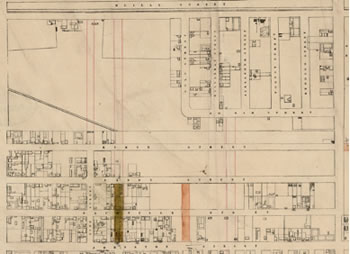| Plan showing streets and buildings of Collingwood in January 1858 |
The sixth child of JDT & JFG, Margaret Martha, was born in Collingwood in September 1858. She was the last child to pass away, in 1937 aged 78. Their seventh child, William Georgewas also born in Collingwood. However, he was born in 1861, but died 8 months la ter. The eight child of this union was George William, born in Collingwood in 1863. The nineth, and final child of JDT & JFG, Hubert Percival lived for just over three weeks at the end of 1870. By this time, JDT was 47, and JFG 46. At that time, childbirth invariably occurred in the home with a local 'midwife'.
The important 'tracking' thing to note here is that Hubert was born in Richmond. He was also born in the year that JDT opened his first iron monger's shop. More on the retail venture in a later post.
So, from late in 1858 until at least 1863, the family lived in the Melbourne suburb of Collingwood. It is tempting to guess that Collingwood was their home from March 1857 until 1870, but I do not have evidence for this just yet, Need Victorian electoral rolls. This is a crucial period during which JDT established himself, and cobbled together sufficient capital to buy out an existing retail store, and be able to stock it. Why were JDT and Collingwood such a good match at that time? What did the area have to offer?
The plans and layout for the suburb we now know as Collingwood, were begun in 1838, with the area being declared separate from Melbourne in 1855. The 1854 census stated the population of the area to be 8,738. In 1863, this had risen to 19,000. Mostly, this was the lure of the gold fields, but there were also many people who made their fortune by catering to the gold rush. JDT was not only a carpenter, but he was the son of a chandler. Items that could be found in a chandlery might include: rosin, turpentine, tar, pitch (resin), linseed oil, whale oil, tallow, lard, varnish, twine, rope and cordage, hemp, oakum, tools (hatchet, axe, hammer, chisel, planes, lantern, nail, spike, boat hook, caulking iron, hand pump, marlinspike), brooms, mops, galley supplies, leather goods, and paper. It is not far from a chandler to an ironmonger, by way of carpentry.
Next: the small business owner, 1870.
,+Robert+(1849),+John+(1853).jpg) | Sons of JDT & JFG. Photo taken about 1861: Andrew (1856), Robert (1849), John (1853) |


















,+Robert+(1849),+John+(1853).jpg)
.jpg)
.jpg)
